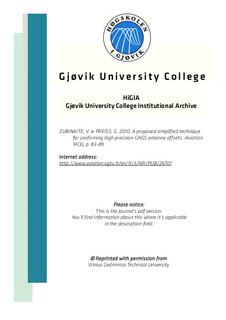| dc.contributor.author | Zubinaite, Vilma | |
| dc.contributor.author | Preiss, George | |
| dc.date.accessioned | 2010-11-26T12:16:24Z | |
| dc.date.available | 2010-11-26T12:16:24Z | |
| dc.date.issued | 2010 | |
| dc.identifier.citation | Aviation, vol. 14, nr. 3, p. 83-89 | en_US |
| dc.identifier.issn | 1648-7788 | |
| dc.identifier.uri | http://hdl.handle.net/11250/142575 | |
| dc.description | This is the journal's version originally published in Aviation. Reprinted with permission from Vilnius Gediminas Technical University: http://www.vgtu.lt/english/ | en_US |
| dc.description.abstract | The purpose of this research was to independently investigate and determine confirmatory calibration procedures for GNSS antennas. This paper focuses on the aspect of simplified techniques for confirming high precision GNSS antenna offsets. In the other words, the aim is to verify GNSS antenna offset parameters - results, which will be used to find the consequences on ground positions of orbital distortions caused by solar activity. It is well known that the computation of GNSS observations using high precision GNSS antennas requires knowledge of the relevant antenna phase centre offsets. These offsets are the distance in three dimensions from the antenna's physical centre to the point in space at which the antenna "measures" position. The calibration processes used by manufacturers appear to vary, and, where receivers of different models are to be used together, it is essential that the calibration parameters used are all produced using the same methods and by the same authoritative sources. Meanwhile, with the growth in the use of high precision GNSS systems, the likelihood of antennas being accidentally mishandled is possibly higher than previously. Finally, it is noted that it has long been the practise for surveyors to check their instruments to ensure that they are properly calibrated. In the modern electronic age, however, it seems that this practise has been allowed to lapse as far as GNSS instrumentation is concerned. With the above in mind, it has been decided to attempt to create a simplified procedure for calibrating high precision GNSS antennas. The aim is that it will be possible for the average surveyor to check his antenna without great effort or trouble. The objective can also be described as finding a simplified field procedure to determine whether a specific antenna's offset parameters are within reasonable agreement with published figures. | en_US |
| dc.language.iso | eng | en_US |
| dc.publisher | Vilnius Gediminas Technical University | en_US |
| dc.relation.uri | http://www.aviation.vgtu.lt/en/lt/3/NR/PUB/26701 | en_US |
| dc.subject | GNSS antenna | en_US |
| dc.subject | phase centre offsets | en_US |
| dc.title | A proposed simplified technique for confirming high precision GNSS antenna offsets | en_US |
| dc.type | Journal article | en_US |
| dc.type | Peer reviewed | en_US |
| dc.subject.nsi | VDP::Technology: 500::Information and communication technology: 550::Geographical information systems: 555 | en_US |
| dc.source.pagenumber | 6 | en_US |
